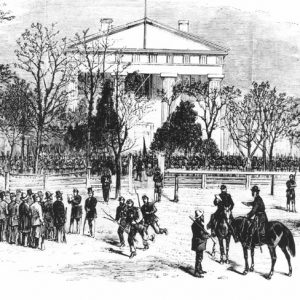calsfoundation@cals.org
William Ayers Crawford (1825–1874)
William Ayers Crawford’s importance to Arkansas history stems from his service to the Confederacy and his participation in Arkansas’s postwar political crises, the most visible of which was the Brooks-Baxter War.
William Crawford was born on June 24, 1825, in Washington County, Tennessee, the youngest of eleven children of William Ayers Crawford and Martha Blakely Crawford. His father was a farmer and breeder of fine horses; he died in 1834. Following his mother’s death in 1840, the orphaned Crawford left Tennessee with older siblings. After passing through Little Rock (Pulaski County) en route to Texas, they changed their original plan and made Saline County their permanent home, farming for a living.
In June 1846, Crawford enlisted for service in the Mexican War, participating in the Battle of Buena Vista as a private in Captain William K. Inglish’s Company “I,” Arkansas Regiment Mounted Volunteers. He returned home in 1848 and married Sarah Helen Henslee on October 5, 1848. They had eight children.
In 1852, Crawford was elected Saline County sheriff and served until 1858, when he was elected to the state House of Representatives for the 1858–59 session. Crawford ran a licensed ferry service across the Saline River used by the El Paso stage line. He also was the contractor for the Saline County Courthouse in Benton, which was constructed in 1857.
Crawford volunteered for service in the Confederate army in 1861, when there was a call for men to come to the defense of Richmond, Virginia. Advancing through the ranks from lieutenant to colonel, he saw service in northern Virginia and southern Arkansas, with briefer periods in Tennessee, Mississippi, and Missouri. At the Battle of Shiloh, he suffered a serious injury when a shell exploded at his feet.
In 1873, Crawford received a brigadier general’s commission from Governor Elisha Baxter, organized the Arkansas State Militia, and was soon caught up in the Brooks-Baxter War, a political skirmish over who held claim to the governorship of Arkansas. On May 9, 1874, Crawford received a head wound in a skirmish in front of the Anthony House, Little Rock’s finest hotel; it was serious enough that he had to return home to recuperate. A week later, President Ulysses S. Grant proclaimed Baxter the governor.
On June 3, 1874, Major General Robert C. Newton telegraphed Crawford, proposing that he run for election as a delegate to the Arkansas Constitutional Convention. On June 22, 1874, less than three weeks later, Crawford died of phthisis (known today as tuberculosis). He is buried at Lee Cemetery in Benton (Saline County).
For additional information:
Crawford, Sybil F. “Science Takes a Look: William A. Crawford’s Burial Vault.” The Saline 20 (April 2005): 19–32.
Williams, Charles G., ed. “A Saline Guard: The Civil War Letters of Col. William Ayers Crawford, C.S.A., 1861–1865.” Arkansas Historical Quarterly 31 (Winter 1972): 328–355.
———. “A Saline Guard: The Civil War Letters of Col. William Ayers Crawford, C.S.A., 1861–1865, Part II.” Arkansas Historical Quarterly 32 (Spring 1973): 71–93.
Sybil F. Crawford
Dallas, Texas
 Brooks-Baxter War
Brooks-Baxter War 



Comments
No comments on this entry yet.